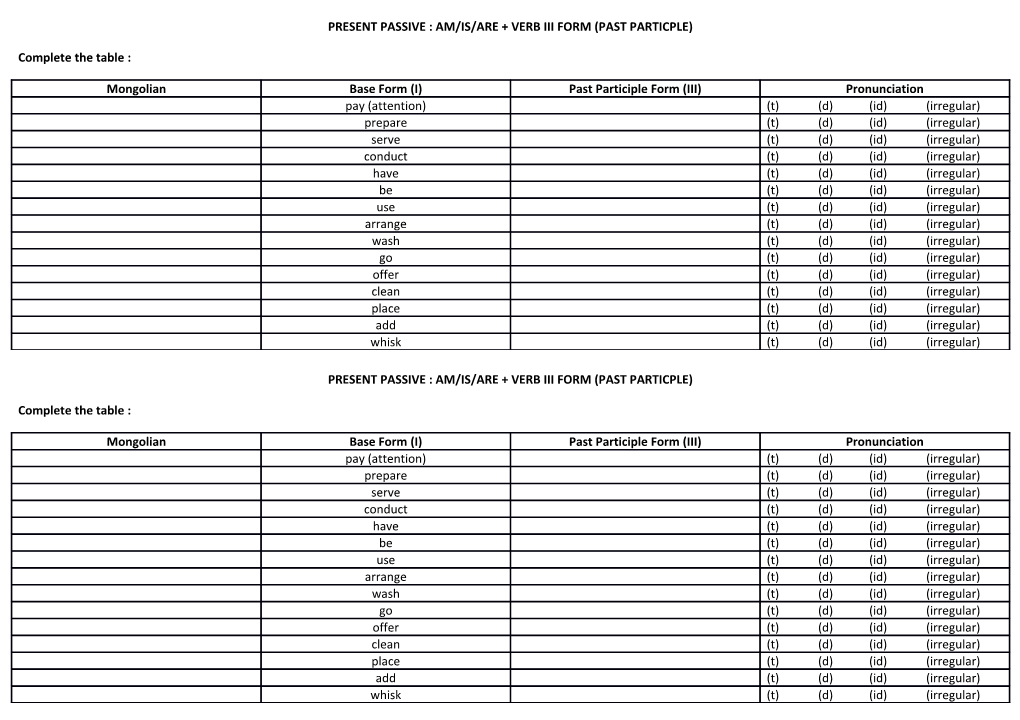PRESENT PASSIVE : AM/IS/ARE + VERB III FORM (PAST PARTICPLE)
Complete the table :
Mongolian / Base Form (I) / Past Participle Form (III) / Pronunciationpay (attention) / (t) (d) (id) (irregular)
prepare / (t) (d) (id) (irregular)
serve / (t) (d) (id) (irregular)
conduct / (t) (d) (id) (irregular)
have / (t) (d) (id) (irregular)
be / (t) (d) (id) (irregular)
use / (t) (d) (id) (irregular)
arrange / (t) (d) (id) (irregular)
wash / (t) (d) (id) (irregular)
go / (t) (d) (id) (irregular)
offer / (t) (d) (id) (irregular)
clean / (t) (d) (id) (irregular)
place / (t) (d) (id) (irregular)
add / (t) (d) (id) (irregular)
whisk / (t) (d) (id) (irregular)
PRESENT PASSIVE : AM/IS/ARE + VERB III FORM (PAST PARTICPLE)
Complete the table :
Mongolian / Base Form (I) / Past Participle Form (III) / Pronunciationpay (attention) / (t) (d) (id) (irregular)
prepare / (t) (d) (id) (irregular)
serve / (t) (d) (id) (irregular)
conduct / (t) (d) (id) (irregular)
have / (t) (d) (id) (irregular)
be / (t) (d) (id) (irregular)
use / (t) (d) (id) (irregular)
arrange / (t) (d) (id) (irregular)
wash / (t) (d) (id) (irregular)
go / (t) (d) (id) (irregular)
offer / (t) (d) (id) (irregular)
clean / (t) (d) (id) (irregular)
place / (t) (d) (id) (irregular)
add / (t) (d) (id) (irregular)
whisk / (t) (d) (id) (irregular)
4. Fill in the correct present active or passive voice form of the verb in brackets.English VII page 63
The Japanese tea ceremony was designed so that attention ______(pay) to all the details of the tea ceremony. The tea ______(prepare) by a skilled person and ______(serve) to a small number of guests. The tea ceremony ______(conduct) in the ‘tearoom’, which every traditional Japanese house ______(have). Everything in the room ______(be) very important. The utensils ______(use) for serving the tea. The flowers ______(arrange). Guests ______(wash) their hands and ______(go) into a small garden where they ______(offer) sweets. Then they ______(go) into the tearoom. The tea utensils ______(clean) in front of the guests. Some green powder ______(place) in the bowl and water ______(add). The host ______(whisk) the tea and it ______(serve) to the guests.
Make the PASSIVE sentences ACTIVE : EXAMPLE :
PASSIVEThe Japanese tea ceremony was designed so that attention is paid to all the details of the tea ceremony. / ACTIVE
Japanese people designed the tea ceremony so that everyone pays attention to all the details of the tea ceremony.
4. Fill in the correct present active or passive voice form of the verb in brackets.English VII page 63
The Japanese tea ceremony was designed so that attention ______(pay) to all the details of the tea ceremony. The tea ______(prepare) by a skilled person and ______(serve) to a small number of guests. The tea ceremony ______(conduct) in the ‘tearoom’, which every traditional Japanese house ______(have). Everything in the room ______(be) very important. The utensils ______(use) for serving the tea. The flowers ______(arrange). Guests ______(wash) their hands and ______(go) into a small garden where they ______(offer) sweets. Then they ______(go) into the tearoom. The tea utensils ______(clean) in front of the guests. Some green powder ______(place) in the bowl and water ______(add). The host ______(whisk) the tea and it ______(serve) to the guests.
Make the PASSIVE sentences ACTIVE : EXAMPLE :
PASSIVEThe Japanese tea ceremony was designed so that attention is paid to all the details of the tea ceremony. / ACTIVE
Japanese people designed the tea ceremony so that everyone pays attention to all the details of the tea ceremony.
